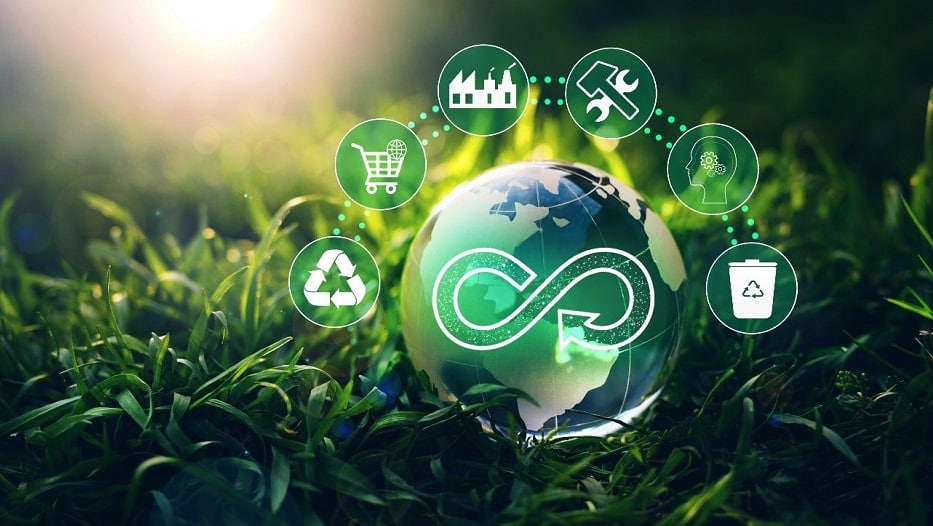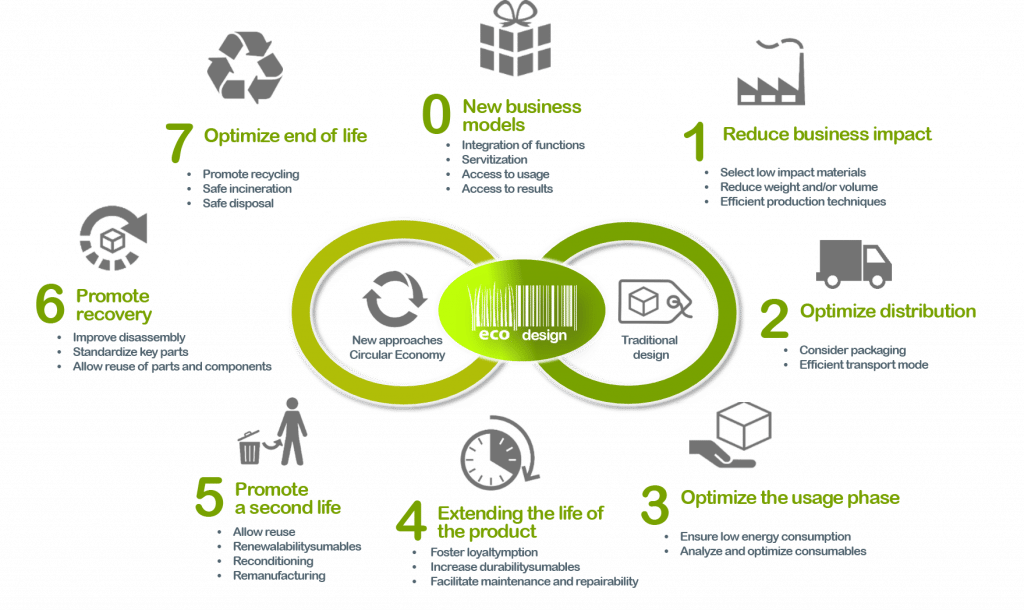Sustainability has grown from being an added value to an unavoidable goal for large industries. Both the market and governments have increased their environmental demands and companies are looking to reduce their impact on the environment by taking action from the earliest stage: design.
The ecological transition has become a goal that is completely in parallel with economic and social development. As Jose María Fernández Alcalá, Director of Circular Economics of Ihobe (Public Environmental Management Society of the Basque Government) explains to us, “sustainability is both part of the mindset of companies and consumers, as well as political agendas,” with overall increasing awareness of the environmental problems generated by our way of producing and consuming.
Legislation and quality controls are increasing the demands on products being marketed, creating a new circular economy paradigm. As the expert points out, Europe’s bet on the future is clear, as the European Green Deal demonstrates, with a set of proposals to adapt EU policies on climate, energy, transportation and taxation in order to reduce greenhouse gas emissions by at least 55%, by 2030.
The Keys to Ecodesign
In this context, design plays a fundamental role, seeing that “80% of the environmental impact that a product will have over its entire life is determined at this phase,” says Fernández Alcalá. Some of the eco-innovative solutions focus on the quantity and type of raw material used. The strategies used in material savings have, as the expert reveals, two distinct approaches:
– The first, more traditional, focuses on determining the typology of materials that are incorporated into the different parts and components of the product, prioritizing whenever possible the use of materials of renewable origin rather than those of a finite resource. And, if it has to be the latter, materials that are recycled. “A second line of action seeks to ensure that the design allows us to reduce the amount of raw material used as much as possible. This covers not only the product itself, but also those consumables that it will use throughout its life cycle or the packaging system for its transportation and distribution phase,” explains the Ihobe manager.
– The second strategy is associated with circularity principles based on increased product durability. “The ultimate goal is for the product to need the least possible amount of raw material. So when we design products that last longer, the weight of the manufacturing unit is likely to be higher than for short-lived products. That’s because we need more material to make your parts stronger and more resilient. However, if we look at the product per unit of use, we see that this increase in material consumption is strongly offset by the increase in its useful life,” he warns.
As can be seen, the development of action strategies linked to eco-design is to address these sustainability objectives in isolation. “In order to properly size the system of a given product, it is necessary to analyze its entire life cycle,” says the expert, who recalls that throughout each phase “both the consumption of raw materials and energy (what we call inputs) are generated, as well as emissions, discharges and waste (outputs).”
Waste management
Jose María Fernández Alcalá recognizes that when aspiring to the circular economy, efforts tend to be focused solely on making use of the waste generated by industrial activity or recycling it. This is certainly a positive strategy; it’s not purely economy-driven to try to recycle waste as much as possible. But eco-design goes a lot further. “Many of the products that become waste are so poorly designed that it is virtually impossible to make use of the raw materials they contain. Or, to put it another way, it’s much easier to recycle a product that’s been designed for this than one that hasn’t,” he says. This can be accomplished, for example, by analyzing the types of material that makes up the final product, studying how they could be separated at the end of their useful life.
To achieve this very important change, it will take commitment from companies that has not yet been seen. “Over the past three decades, we have seen a proliferation of thoughtful design strategies aimed at shortening the life of products. This is so-called ‘programmed obsolescence’, which pursues a goal of early failure of the product, so that its rapid replacement is encouraged or the even more feared ‘perceived obsolescence’, whereby the product, without failing, has been conceived in such a way that it plays on the consumer’s psychology so that they voluntarily wish to replace it despite the fact that it still has a remaining life,” he warns. At this point, measures ranging from preventing technical failures to facilitating repair could also be carried out.
Benefits and positive impact of eco-design
An industrial design geared towards environmental objectives always has a positive impact on the environment in which it is developed. This can be direct —for example, when local raw materials are prioritized— as well as indirect, since they can be produced globally in those geographic environments where the product is distributed, used, and converted into waste. In addition, as the expert points out, “thanks to the increasing awareness of consumption, eco-design can bring about a significant improvement in the competitiveness of the company that applies it, as it will improve its image to potential customers.”
From the workers’ perspective, “applying ecodesign can lead to the replacement of highly polluting or harmful processes and materials. This also results in improved working conditions,” says Ihobe’s Director of Circular Economy. We can also talk about a positive impact on product value, as well as profitability for the business owner. “Raw materials usually comprise the main cost of production. For example, in the industrial costs of companies in the Basque Country, raw materials account for 61% of the total, while, for example, labor accounts for only 15%. Therefore, if we optimize the consumption of materials, we will be reducing costs in many cases,” he says. It also increases its value to the customer, as according to different studies, 78% of European consumers are willing to pay more for a product that demonstrably shows respect for the environment.
Lastly, Fernández Alcalá reminds us that eco-design is a fundamental step in achieving the objectives set by the world’s leading governments in terms of sustainability and the environment. “According to data from the Ellen MacArthur Foundation, the full application of eco-design principles within the framework of a circular economy in Europe could result in a reduction of 45% of these emissions associated with products, which would result in a net reduction of 450 million tonnes of carbon by 2030,” he affirms, adding that it would also result in savings of €600 billion for EU companies.
These benefits would only be possible and feasible, from within the industrial fabric, by rethinking business models, studying new measurement and evaluation tools and, above all, improving technical skills. The other challenge comes from the market and the competent authorities. “It is necessary for the administrations to act decisively to ensure that the consumer is given truthful information, to discourage so-called greenwashing, which does nothing but deceive and prevents the consumer from being able to differentiate a correct eco-design from a simple illusion. If we succeed in overcoming these two challenges, eco-design will become the new standard in our markets,” he concludes.
Article collaborator:
Jose María Fernández Alcalá is Director of Circular Economy at Ihobe, Environmental Agency of the Basque Government and responsible for the Basque Ecodesign Center, a public-private alliance in ecodesign and circular economy of Euskadi. He has more than 15 years of experience in private enterprise and public administration. A Mechanical Industrial Engineer from the Bilbao High School of Engineering (UPV), he has a Diploma of Advanced Studies from the same center for his work “Engineering the Ecological Design of Industrial Products”. Author of numerous publications, he is also a member of various EU technical committees in Brussels and is on national and international committees for product design and standardization.
Ihobe, Environmental Agency of the Basque Government and responsible for the Basque Ecodesign Center, a public-private alliance in ecodesign and circular economy of Euskadi. He has more than 15 years of experience in private enterprise and public administration. A Mechanical Industrial Engineer from the Bilbao High School of Engineering (UPV), he has a Diploma of Advanced Studies from the same center for his work “Engineering the Ecological Design of Industrial Products”. Author of numerous publications, he is also a member of various EU technical committees in Brussels and is on national and international committees for product design and standardization.
Keep reading… Steel: Its Contribution to Sustainable Construction






